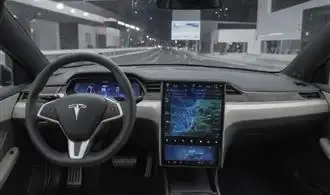
Optimize Your Driving Habits
Maximizing the range of your Tesla Model 3 starts with your driving behavior. Small adjustments to your driving style can have a significant impact on the vehicle's energy efficiency. Here are some tips to optimize your driving habits and squeeze the most out of your battery:
Smooth Acceleration and Braking: Rapid acceleration and harsh braking can dramatically reduce your Tesla's range. Aim for gradual, smooth inputs on the accelerator and brake pedal. Anticipate traffic conditions and coast to a stop whenever possible to maximize regenerative braking.
Maintain Optimal Speed: The Tesla Model 3 is most efficient at moderate speeds, typically between 45-65 mph. Driving at higher speeds increases aerodynamic drag and reduces range. Consider using Autopilot or cruise control to maintain a steady, optimal speed.
Minimize Climate Control Usage: The climate control system in your Tesla Model 3 can have a significant impact on battery consumption. Minimize the use of heating, cooling, and seat/steering wheel heaters when not necessary. Take advantage of the Model 3's pre-conditioning feature to heat or cool the cabin while the vehicle is still plugged in.
Tire Pressure Maintenance: Properly inflated tires can improve rolling resistance and enhance your Tesla's range. Check your tire pressure regularly and ensure it matches the recommended levels specified by Tesla.
Route Planning and Navigation: Plan your routes thoughtfully to avoid unnecessary detours or high-traffic areas. Utilize the Tesla's navigation system to find the most efficient routes, which can factor in elevation changes, traffic conditions, and other range-impacting factors.
Regenerative Braking Optimization: The Tesla Model 3's regenerative braking system can recover a significant amount of energy during deceleration. Familiarize yourself with the different regenerative braking settings and choose the one that best suits your driving style and road conditions.
Leverage Regenerative Braking
One of the most powerful features of the Tesla Model 3 is its regenerative braking system. This technology allows the car to capture kinetic energy during deceleration and convert it into electricity, which is then stored in the battery. This not only extends the vehicle's range but also reduces wear and tear on the traditional brake pads and discs.
To maximize the benefits of regenerative braking, Tesla owners should familiarize themselves with the various settings and customization options available. The Model 3 offers multiple levels of regenerative braking, allowing drivers to choose the intensity that best suits their driving style and needs. Selecting a higher regenerative braking setting will result in more aggressive deceleration when the driver lifts off the accelerator, providing a stronger "one-pedal driving" experience and greater energy recovery.
In addition to adjusting the regenerative braking settings, Tesla owners can also optimize their driving technique to further enhance the system's effectiveness. Anticipating stops and gradual deceleration can help ensure that the maximum amount of kinetic energy is captured and converted into electrical energy. Avoiding sudden braking and maintaining a smooth, steady driving style can significantly improve the Model 3's overall range and efficiency.
Another important consideration is the impact of environmental factors on regenerative braking. Factors such as temperature, road conditions, and driving terrain can all affect the system's performance. Tesla owners should be aware of these variables and adjust their driving accordingly to maximize the benefits of regenerative braking.
Precondition Your Battery
Maximizing the range of your Tesla Model 3 is crucial for your daily commute and longer road trips. One effective way to achieve this is by preconditioning your battery. Preconditioning is the process of warming or cooling your battery to the optimal temperature before driving, ensuring it operates at peak efficiency.
The Tesla Model 3's battery performs best when it is within a specific temperature range. If the battery is too cold, it will not be able to deliver its full power capacity, leading to reduced range. Conversely, if the battery is too hot, it may need to throttle performance to prevent overheating, also resulting in decreased range.
By preconditioning your battery, you can ensure it is at the ideal temperature before you start your journey. This can be done in a few ways:
- Schedule your departure time in the Tesla app. This will allow the car to precondition the battery while it's still plugged in, ensuring it's ready to go when you are.
- Use the "Scheduled Departure" feature in the car's climate control settings. This will automatically precondition the battery based on your scheduled departure time.
- Initiate battery preconditioning manually by tapping the battery icon in the car's touchscreen and selecting the "Precondition" option.
It's important to note that preconditioning does consume some energy from the battery, so it's best to do it while the car is still plugged in. This way, you're not depleting your driving range before you even start your journey.
Additionally, be mindful of the weather conditions. On very cold days, you may need to precondition the battery for a longer period to ensure it reaches the optimal temperature. Conversely, on hot days, you may want to precondition the battery to a slightly lower temperature to prevent it from overheating during your drive.
Utilize Energy-Saving Features
Maximizing the range of your Tesla Model 3 is not just about driving efficiently. The vehicle's advanced energy-saving features can significantly contribute to extending your battery life. One of the most crucial aspects is the regenerative braking system, which captures the energy generated during deceleration and stores it in the battery. This system can recover a substantial amount of energy, reducing the overall drain on the battery and enhancing your driving range. Make sure to familiarize yourself with the different regenerative braking settings available and experiment to find the one that works best for your driving style.
Another important feature to leverage is the Tesla Model 3's highly efficient climate control system. Unlike traditional HVAC systems, the Tesla utilizes a heat pump, which is significantly more energy-efficient than a conventional compressor-based system. The heat pump can effectively heat or cool the cabin while consuming less energy, leading to improved overall efficiency and range. Additionally, the climate control system in the Model 3 offers various modes and settings that allow you to fine-tune the temperature and airflow to your preferences, further optimizing energy usage.
Monitor Your Climate Control
Optimizing the climate control system in your Tesla Model 3 is crucial for maximizing your vehicle's range. The climate control system is responsible for regulating the temperature and airflow within the cabin, which can have a significant impact on your car's energy consumption. By closely monitoring and adjusting your climate control settings, you can ensure that you're not unnecessarily draining your battery and can extend the overall range of your Tesla Model 3.
One of the most important factors to consider is the temperature setting. While it may be tempting to crank up the heat or air conditioning to achieve your desired comfort level, this can come at a cost to your battery life. Instead, aim for a moderate temperature setting, typically around 68-72 degrees Fahrenheit (20-22 degrees Celsius). This range will provide a comfortable cabin environment without putting excessive strain on your vehicle's climate control system.
Additionally, be mindful of the airflow settings. Avoid using the maximum fan speed, as this will consume more energy than a lower fan setting. Instead, opt for a lower fan speed and gradually increase it if needed to maintain your desired temperature. You can also experiment with the air distribution settings, directing the airflow towards specific areas of the cabin rather than having it circulate throughout the entire space.
If your Tesla Model 3 is equipped with a heat pump, it's important to understand how this technology can impact your range. Heat pumps are generally more energy-efficient than traditional heating systems, as they use the ambient heat in the air to warm the cabin. However, in extremely cold weather, the heat pump may need to work harder, which can result in a higher energy consumption. In these situations, consider using the car's resistance heater instead, as it may be more efficient.
Another factor to consider is the use of seat and steering wheel heaters. These features can be highly useful in colder climates, as they allow you to warm specific areas of your body without needing to heat the entire cabin. Using these targeted heating systems can help you maintain comfort while conserving battery life.
Optimize Wheel and Tire Choice
Choosing the right wheels and tires for your Tesla Model 3 can have a significant impact on your vehicle's range and efficiency. The Model 3's aerodynamic design is a crucial factor in maximizing its electric driving range, and the wheels and tires play a crucial role in this equation. Here are some key considerations to optimize your wheel and tire choice for maximum range:
Aerodynamic Wheels: The Tesla Model 3 is designed with aerodynamics in mind, and this extends to the wheel design. Opt for wheels with a sleek, low-profile design that minimizes drag. Tesla's standard aero wheels, for example, are engineered to improve airflow and reduce wind resistance, contributing to better range. Aftermarket wheels with a similar aerodynamic profile can also be a good choice.
Tire Rolling Resistance: The rolling resistance of your tires is another crucial factor in determining your Tesla Model 3's range. Tires with lower rolling resistance can significantly improve efficiency and extend your driving range. Look for tires specifically designed for electric vehicles, as they often have a lower rolling resistance compared to traditional tires.
Tire Size: The size of your tires can also impact your range. Larger tires, while providing a more comfortable ride, can increase rolling resistance and reduce efficiency. Stick to the tire size recommended by Tesla for your specific Model 3 configuration. Upgrading to larger tires may seem appealing, but it's important to consider the trade-off in range.
Tire Pressure: Maintaining the correct tire pressure is crucial for maximizing your Tesla Model 3's range. Underinflated tires create more rolling resistance, leading to decreased efficiency and range. Regularly check your tire pressure and keep it at the recommended level, as specified by Tesla.
Leverage Charging Strategies
Optimizing your Tesla Model 3's range goes beyond just driving efficiently. Charging strategies play a crucial role in maximizing the battery's potential. Consider these tips to make the most of your charging sessions:
Prioritize Destination Charging: When possible, take advantage of destination charging options at your workplace, the mall, or other locations you frequent. Charging your Tesla Model 3 at these destinations can help replenish the battery during the time you're already spending there, minimizing the need for additional charging stops.
Utilize Regenerative Braking: Your Tesla Model 3 is equipped with regenerative braking, which captures energy from braking and converts it back into stored electricity. By being mindful of your driving and braking habits, you can maximize the energy recaptured through regenerative braking, extending your overall range.
Optimize Charging Speeds: Understand the different charging options available to you, such as Level 1 (household outlet), Level 2 (public or home charging station), and Supercharging. Utilize the fastest charging method appropriate for your needs and available infrastructure to reduce the time spent charging.
Monitor Battery Degradation: Over time, your Tesla Model 3's battery may experience some degradation, which can impact its overall range. Regularly monitor your battery's health and consider seeking service if you notice significant changes in its performance.
Precondition the Battery: Before embarking on a long trip, take advantage of the Tesla Model 3's ability to precondition the battery. This process warms or cools the battery to optimal temperatures, enhancing its efficiency and maximizing the available range.
Adjust Driving Modes: Your Tesla Model 3 offers different driving modes, such as Standard, Chill, and Sport. Experiment with these modes to find the right balance between performance and energy efficiency, depending on your driving needs and the conditions you encounter.


















